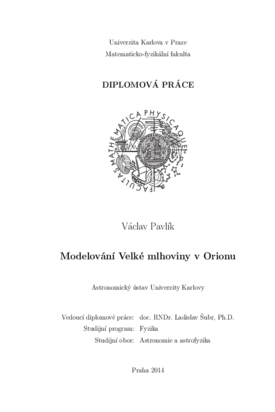Modelování Velké mlhoviny v Orionu
Modelování Velké mlhoviny v Orionu
diplomová práce (OBHÁJENO)

Zobrazit/
Trvalý odkaz
http://hdl.handle.net/20.500.11956/67462Identifikátory
SIS: 127979
Kolekce
- Kvalifikační práce [10932]
Autor
Vedoucí práce
Oponent práce
Jungwiert, Bruno
Fakulta / součást
Matematicko-fyzikální fakulta
Obor
Astronomie a astrofyzika
Katedra / ústav / klinika
Astronomický ústav UK
Datum obhajoby
12. 5. 2014
Nakladatel
Univerzita Karlova, Matematicko-fyzikální fakultaJazyk
Angličtina
Známka
Výborně
Klíčová slova (česky)
metody: N-částicové simulace, metody: analýza dat, hvězdokupy: konkrétní (M42), hvězdy: dynamikaKlíčová slova (anglicky)
methods: N-body simulations, methods: data analysis, star clusters: individual (ONC), stars: dynamicsNázev práce: Modelování Velké mlhoviny v Orionu Autor: Václav Pavlík Katedra: Astronomický ústav Univerzity Karlovy Vedoucí diplomové práce: doc. RNDr. Ladislav Šubr, Ph.D. (Astronomický ústav Univerzity Karlovy) Abstrakt: Otevřené hvězdokupy jsou často diskutovány z hlediska jejich vývoje a struktury. V této práci jsme se zaměřili na studium typického představitele těchto objektů - Velké mlhoviny v Orionu (M 42) - na základě observačních dat, včetně jejich porovnání s N-částicovými modely od Šubr et al. (2012). Tyto nume- rické modely byly inspirovány nedávno navrženým vývojovým schématem, podle něhož hvězdokupy vznikají z velmi hustých počátečních podmínek. Z analýzy rentgenových zdrojů se ukázalo jako pravděpodobné, že M 42 je rotačně symet- rická ve vnitřních oblastech do 0.7 pc. Další analýzou zahrnující též observační da- ta z optického a infračerveného oboru jsme došli k závěru, že M 42 má na větších poloměrech (do 2 pc) protáhlý tvar od severovýchodu na jihozápad. Porovnali jsme rovněž radiální profily různých hmotnostních skupin hvězd. Objevili jsme náznak inverzní hmotové segregace mezi hvězdami s hmotností v rozsahu od 1 do 5 M⊙ a hvězdami s hmotností menší než 0.5 M⊙, a to v oblasti...
Title: Modelling the Orion Nebula Cluster Author: Václav Pavlík Department: Astronomical Institute of the Charles University Supervisor: doc. RNDr. Ladislav Šubr, Ph.D. (Astronomical Institute of the Charles University) Abstract: Young star clusters are widely discussed from the point of view of their evolution and structure. In this work we focused our attention on studying a typical representative of these objects - the Orion Nebula Cluster (ONC, M 42) - based on the observational data, including their confrontation with N- body models from Šubr et al. (2012). These numerical models were inspired by the recently proposed evolutionary scenario, according to which the star clusters begin their evolution from very dense initial conditions. From the analysis of the X-ray sources we revealed that the ONC is likely to be rotationally symmetric in the inner area (� 0.7 pc). Further analysis including also optical and IR observational data led us to the conclusion that the ONC is elongated from the North-East to the South-West on large scales (up to 2 pc). We also compared radial profiles of different mass groups of stars and we discovered a possibly inverse mass segregation between stars with masses in the interval (1 ; 5) M⊙ and the stars less massive than 0.5 M⊙ in the range from 0.5 pc to 1.5 pc. This...
